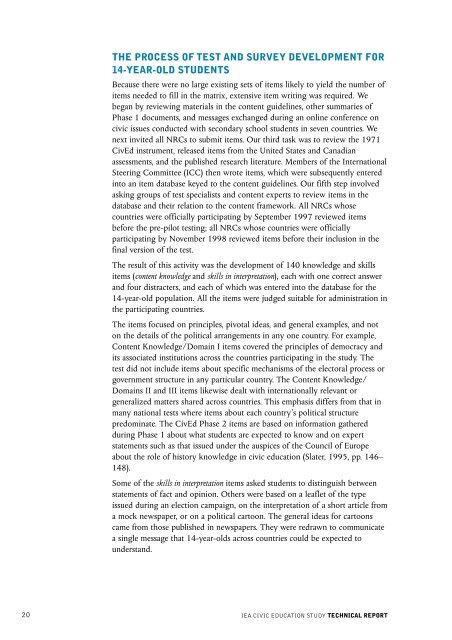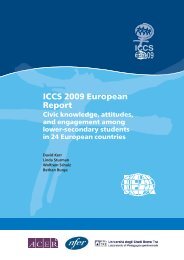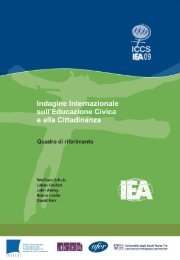- Page 1 and 2: IEA Civic Education StudyTechnical
- Page 3 and 4: IEA Civic Education StudyTechnical
- Page 5 and 6: IEA Civic Education StudyTechnical
- Page 7 and 8: TABLE OF CONTENTSChapter 1: Overvie
- Page 9 and 10: Chapter 1:OVERVIEW OF THE IEA CIVIC
- Page 11 and 12: fundamental concern in all countrie
- Page 13 and 14: THEORETICAL FRAMEWORKWe have alread
- Page 15 and 16: tend to have rather vague notions o
- Page 17 and 18: in Hamburg and the ICC in Berlin; t
- Page 19 and 20: Chapter 2:DEVELOPMENT OF THE CIVEDI
- Page 21: In addition to giving input on the
- Page 25 and 26: political attitudes), and 22 items
- Page 27 and 28: In addition, the background questio
- Page 29 and 30: Chapter 3:TRANSLATION PROCEDURES, F
- Page 31 and 32: Table 3.1 Languages and instrument
- Page 33 and 34: All changes to the format of a ques
- Page 35 and 36: • The Field Operations Manual (IE
- Page 37 and 38: The school coordinator was the key
- Page 39 and 40: participation on the Student Tracki
- Page 41 and 42: followed procedures to protect the
- Page 43 and 44: Chapter 4:THE CIVED SAMPLING DESIGN
- Page 45 and 46: scope of the sampling frame. Partic
- Page 47 and 48: Sampling Precision and Sample SizeS
- Page 49 and 50: Examples of stratification variable
- Page 51 and 52: Second Sampling StageThe second sam
- Page 53 and 54: Table 4.2 Countries grouped accordi
- Page 55 and 56: Table 4.4 Participation rates and s
- Page 57 and 58: Chapter 5:DATA MANAGEMENT ANDCONSTR
- Page 59 and 60: DATA EDITING AT THE IEA DATA PROCES
- Page 61 and 62: Table 5.1 Example of summary statis
- Page 63 and 64: Chapter 6:WEIGHTING PROCEDURESHeiko
- Page 65 and 66: Under equal probability sampling, t
- Page 67 and 68: PARTICIPATION RATESSince lack of pa
- Page 69 and 70: Weighted Student Participation Rate
- Page 71 and 72: Chapter 7:SCALING PROCEDURES FORCOG
- Page 73 and 74:
the whole set of available test ite
- Page 75 and 76:
z i = x i - E(x i )w iwhere x iis t
- Page 77 and 78:
Figure 7.2 Latent ability estimates
- Page 79 and 80:
Figures 7.4 and 7.5 show the ICCs f
- Page 81 and 82:
Table 7.2 Example of statistics for
- Page 83 and 84:
• One or more distracter percenta
- Page 85 and 86:
Table 7.3 Items excluded from scali
- Page 87 and 88:
was not used for the anchoring of t
- Page 89 and 90:
Table 7.7 Percentage correct and it
- Page 91 and 92:
Table 7.10 Means and standard devia
- Page 93 and 94:
Two sub-scales were derived from th
- Page 95 and 96:
Chapter 8:SCALING PROCEDURES FOR LI
- Page 97 and 98:
• The non-normed fit index (NNFI)
- Page 99 and 100:
substantively for the second dimens
- Page 101 and 102:
Table 8.3 Scale reliabilities for c
- Page 103 and 104:
Figure 8.2 Two-factor solution for
- Page 105 and 106:
Table 8.6 contd. from previous page
- Page 107 and 108:
Table 8.8 Item parameters for TRUST
- Page 109 and 110:
Figure 8.4 Two-factor solution for
- Page 111 and 112:
Table 8.13 Items on desired opportu
- Page 113 and 114:
Table 8.15 Scale reliabilities for
- Page 115 and 116:
Estimating an IRT partial credit mo
- Page 117 and 118:
Table 8.19 Items on school particip
- Page 119 and 120:
Expected Political ParticipationThe
- Page 121 and 122:
Table 8.24 Scale reliabilities for
- Page 123 and 124:
Figure 8.9 Two-factor solution for
- Page 125 and 126:
If an item had poor scaling propert
- Page 127 and 128:
Table 8.30 International means and
- Page 129 and 130:
Chapter 9:MAPPING STUDENT SCORES TO
- Page 131 and 132:
Figure 9.2 Summed category probabil
- Page 133 and 134:
international metric might suggest
- Page 135 and 136:
Chapter 10:REPORTING STUDENT AND TE
- Page 137 and 138:
Table 10.1 Range of sampling zones
- Page 139 and 140:
The computation of JRR variance can
- Page 141 and 142:
population of upper secondary stude
- Page 143 and 144:
Table 10.5 shows the reported stand
- Page 145 and 146:
Table 10.8 Comparison of standard e
- Page 147 and 148:
Listwise-exclusion of missing value
- Page 149 and 150:
Table 10.11 contd.from previous pag
- Page 151 and 152:
Table 10.12 contd. from previous pa
- Page 153 and 154:
Table 10.14 Unstandardized coeffici
- Page 155 and 156:
Table 10.15 shows a fictitious exam
- Page 157 and 158:
APPENDIX A: ACKNOWLEDGMENTSThe IEA
- Page 159 and 160:
NATIONAL RESEARCH COORDINATORSThe I
- Page 161 and 162:
FINLANDSakari SuutarinenUniversity
- Page 163 and 164:
ROMANIAGheorghe BunescuInstitute fo
- Page 165 and 166:
APPENDIX B: TEST AND QUESTIONNAIRE
- Page 167 and 168:
7. Identifies or recognizes problem
- Page 169 and 170:
obligations which lead to behavior
- Page 171 and 172:
2. Recognizes countries or groups o
- Page 173 and 174:
Table B.1 (continued)I C: Citizensh
- Page 175 and 176:
Table B.2 Domain Content Categories
- Page 177 and 178:
Table B.2 (continued)I C: Citizensh
- Page 179 and 180:
APPENDIX C: TEST AND OPERATION FORM
- Page 181 and 182:
Form 2: Translation Verification Re
- Page 183 and 184:
Form 4: Class Sampling FormCIVIC Pa
- Page 185 and 186:
○ ○ ○ ○ ○ ○ ○ ○ ○
- Page 187 and 188:
Form 7: Student Tracking FormCIVIC
- Page 189 and 190:
APPENDIX D: SAMPLE CHARACTERISTICSD
- Page 191 and 192:
BulgariaTarget PopulationIn Bulgari
- Page 193 and 194:
ColombiaTarget PopulationIn Colombi
- Page 195 and 196:
Czech RepublicTarget PopulationIn t
- Page 197 and 198:
EnglandTarget PopulationIn England,
- Page 199 and 200:
FinlandTarget PopulationIn Finland,
- Page 201 and 202:
Table D.12 contd. from previous pag
- Page 203 and 204:
Hong Kong (SAR)Target PopulationIn
- Page 205 and 206:
ItalyTarget PopulationIn Italy, the
- Page 207 and 208:
LithuaniaTarget PopulationIn Lithua
- Page 209 and 210:
PolandTarget PopulationIn Poland, t
- Page 211 and 212:
RomaniaTarget PopulationIn Romania,
- Page 213 and 214:
Table D.23 contd. from previous pag
- Page 215 and 216:
SloveniaTarget PopulationIn Sloveni
- Page 217 and 218:
Switzerland Target PopulationIn Swi
- Page 219 and 220:
D.2 CIVED OLDER POPULATION (UPPER S
- Page 221 and 222:
CyprusTarget PopulationIn Cyprus, t
- Page 223 and 224:
DenmarkTarget Population (pending)I
- Page 225 and 226:
Hong Kong (SAR)Target PopulationIn
- Page 227 and 228:
LatviaTarget PopulationIn Latvia, t
- Page 229 and 230:
PolandTarget PopulationIn Poland, t
- Page 231 and 232:
Russian FederationTarget Population
- Page 233 and 234:
SloveniaTarget PopulationIn Sloveni
- Page 235 and 236:
Switzerland Target PopulationIn Swi
- Page 237 and 238:
Table E.2:Total civic knowledge (co
- Page 239 and 240:
F.1 CIVIC KNOWLEDGE TEST ITEMSRelea
- Page 241 and 242:
24. The authors of the leaflet thin
- Page 243 and 244:
Additional Release Items for Upper
- Page 245 and 246:
8. Altogether, how many people live
- Page 247 and 248:
16. How often do you spend time dur
- Page 249 and 250:
Democracy (continued)A8 When immigr
- Page 251 and 252:
Good citizens (continued)not somewh
- Page 253 and 254:
SECTION D: TRUST IN INSTITUTIONSIn
- Page 255 and 256:
Our country (continued)E9This count
- Page 257 and 258:
Section G: Opportunities 2In this s
- Page 259 and 260:
Section H: ImmigrantsListed below y
- Page 261 and 262:
Section J: SchoolListed below you w
- Page 263 and 264:
Section L: Political Action 1In thi
- Page 265 and 266:
Section N: ClassroomsThe next part
- Page 267 and 268:
Section O: Effectiveness of Politic
- Page 269 and 270:
F.4 TEACHER QUESTIONNAIRE (STANDARD
- Page 271 and 272:
Part 2: Views on Civic EducationWit
- Page 273 and 274:
What do students learn in your scho
- Page 275 and 276:
Section H: What topics do you teach
- Page 277 and 278:
Section J: In your view, what needs
- Page 279 and 280:
5. Are the following organizations
- Page 281 and 282:
9. What is your best guess about th
- Page 283:
17. How many hours (class period) p




